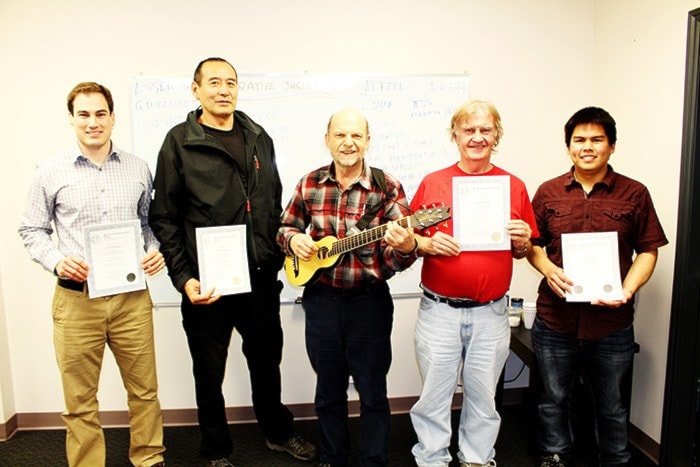The Prince Rupert Aboriginal Community Services Society (PRACSS) is doing its part to ensure that a potential mountain of court cases doesn't pile up and become an unnecessary burden for the legal system here on the North Coast.
An alternative justice program has been proposed for the area, and it's one that has gained steam and is even being promoted by the federal government as a way to cut down on the costs, incarceration sentences and punitive aspects of the modern court system.
It's called restorative justice and executive director for the Aboriginal Community Services Society Oscar Dennis is ensuring that it is well used in the community through two three-day training sessions that took place last month.
Around in Canada since the 1970s and with many cultures and states having different iterations of it around the world, restorative justice focuses on conflict and crime as a violation of people and relationships versus an offence against the state. It aims to mend the harm caused by conflict through a collaborative and inclusive process that reintegrates the offender into the community after a thorough healing process that helps the offender change their behaviour, learn how they have wronged the other party and have a constructive dialogue with affected parties with the goal of promoting trust and harmony.
The offended party is also incorporated into the process and can ask questions, get answers, explain their situation and contribute to the outcome of the process.
“The process enables the community to reinforce its values and expectations, to understand the underlying causes of crime and to determine what can be done to repair the damage caused by crime. Restorative justice serves to promote community well-being and to reduce the future incidence of crime,” explains an RCMP Restorative Justice Community Justice Forum training guide.
The difference between the modern court system and restorative justice is that facts, evidence and the rule of law helps determine whether a crime was committed and if the Crown can prove the offence.
“There is no onus on offenders to take responsibility for their actions. Ultimately, the focus is on the law, proof of guilt by the Crown and the rules that govern the appropriate punishment and treatment of the person found guilty of the offence,” the guide states.
Restorative justice aims for problem solving through the establishment of offenders taking responsibility for their actions through questions like who has been harmed, how have they been harmed, how can the harm be repaired and how can the likelihood of future harm be reduced?
Due to punishment being a primary goal for the court system and with some incarceration situations taking offenders from their communities and placing them somewhere else, and sometimes hindering their professional and social lives, restorative justice tries to deter this alienation through reintegration into the community and victims' involvement in making it possible.
“Reintegration is central to the objective of healing and of repairing harm. Unless everyone touched by an incident is involved in making things right, healing cannot take place,” the guide states.
The first three day course was a Community Justice Forum session which helps lead participants through a script to enable problem solving.
The second, a Peacemaking Circle Facilitation Course, was taught to four participants (with five in the first session), with both sessions offered freely by the Rupert society (normally a multi-hundred dollar course overall).
The society brought West Coast Restorative Justice co-ordinator Myles Morrison (based out of Ucluelet and Tofino, B.C.) to Rupert to lead the courses, which society staff member Kyle Green (justice coordinator), Prince Rupert youth probation officer Tyler Bryant, Lionel Brightson, a principal with Coast Mountains School District, Friendship House youth justice workerAlayna Brown and Dennis attended.
The Aboriginal Community Services Society is promoting the system, which is being called the Aboriginal Justice Program through justice coordinator Wood's work, and its goals are to administer the program for people in the area by incorporating cultural, restorative and holistic approaches, promoting it within schools and public agencies, reducing the number of people in the court system and in detention centres, reduce the recidivism rate and to provide advisory serviuces in relation to court sentencings.
Volunteers are being sought to help with the program, which is funded by the Aboriginal Justice Society and Provincial Corrections and administered through the services society.
“I enjoyed the training and will continue to incorporate restorative justice into my work and assist PRACSS with providing the service to our community. Restorative justice conferencing provides an option to offer meaningful consequences that hold persons accountable, help them to understand the impact of their actions, and allow them to repair the harm done to the victim and community,” said Bryant at the session. “Under the Canadian Victim Bill of Rights, victims have the right to receive information about restorative justice programs during any stage of the criminal justice process.”
The program is not intended to deem the court system unnecessary, however said Morrison.
“Court battles and the resolutions that come from that are certainly necessary and nobody expects that to disappear, but restorative justice costs 1/100th the cost to do and is usually handled within a month, sometimes a week,” said Morrison.
“The backlog in the court system can be really heavily alleviated. The average court case costs $7,000. The average restorative justice case is $100 to $300,” he said, adding that the Minister of Defence in Ottawa has advised the prime minister to spread the system throughout the country.
